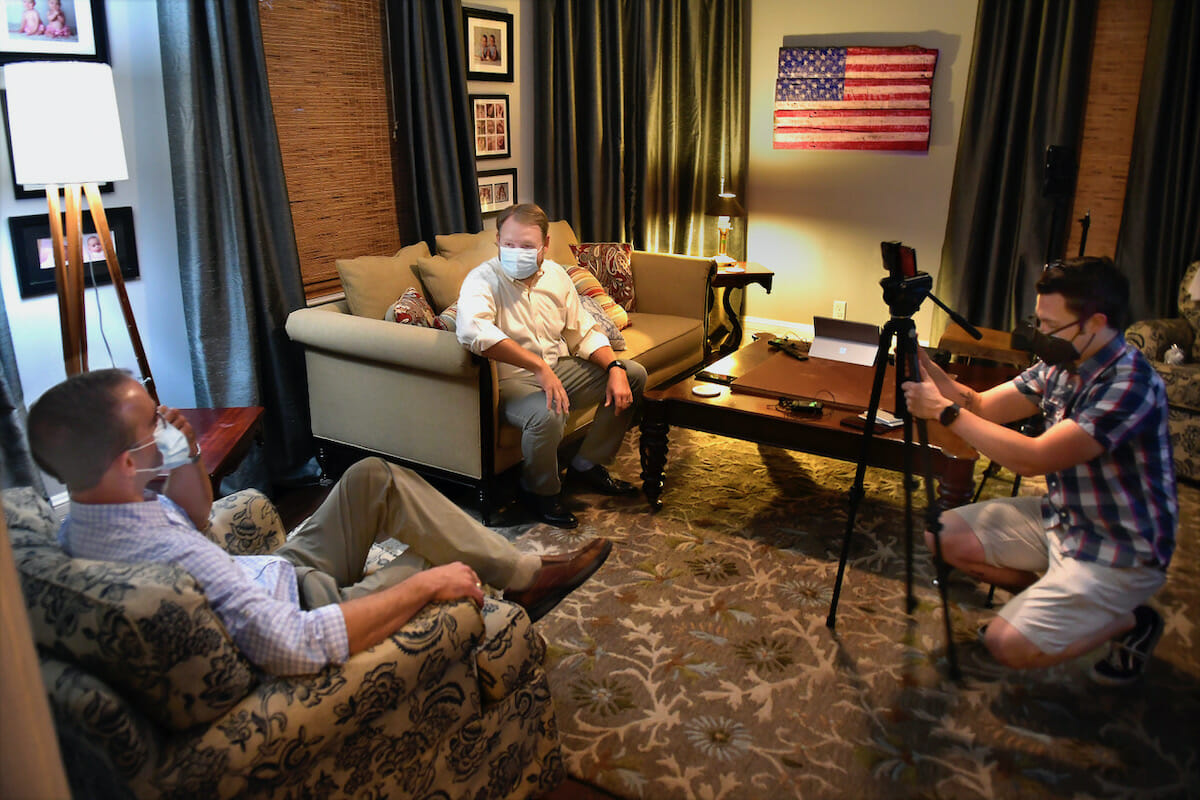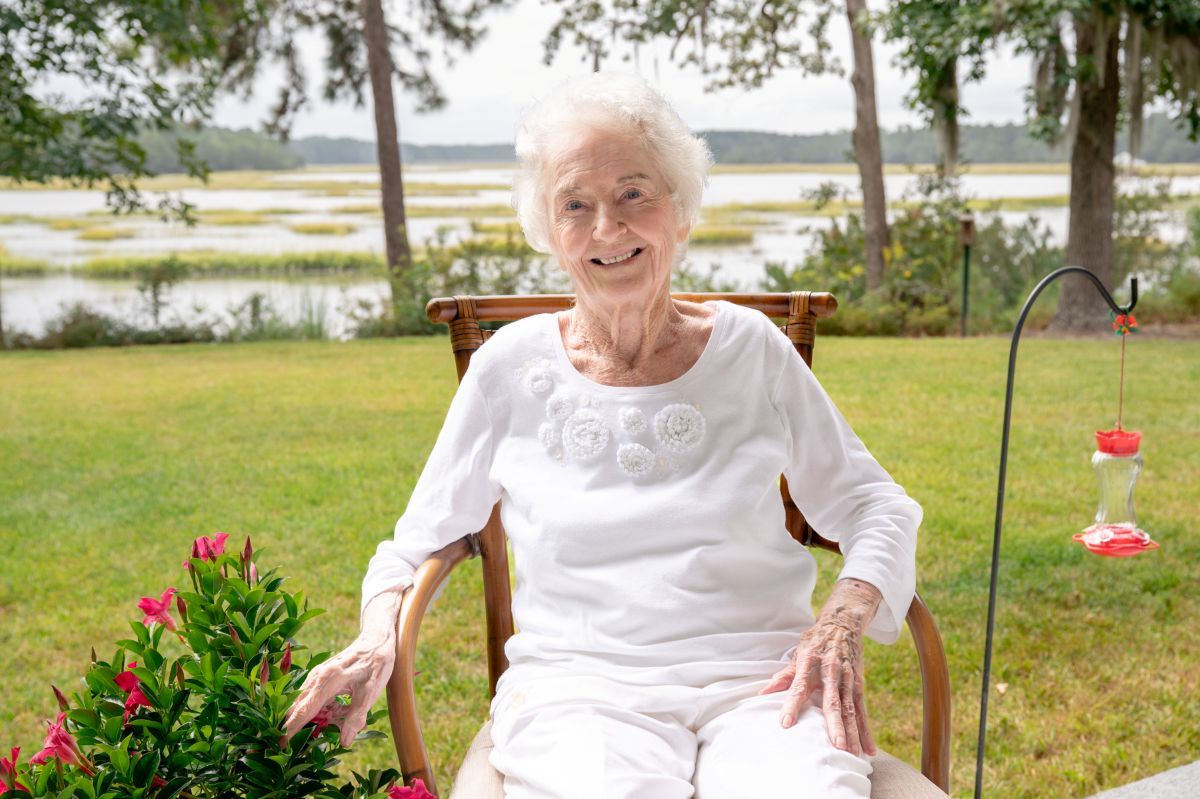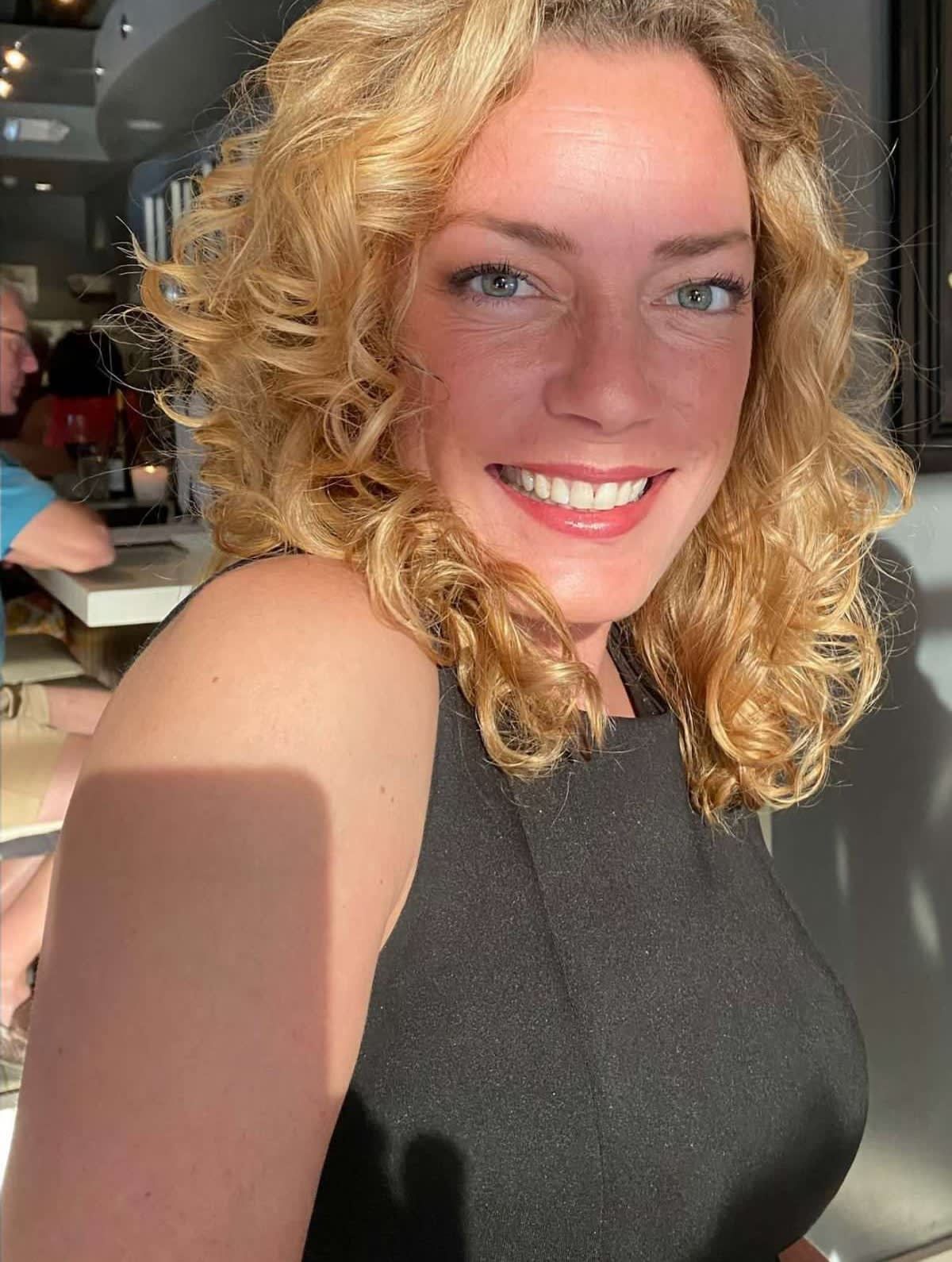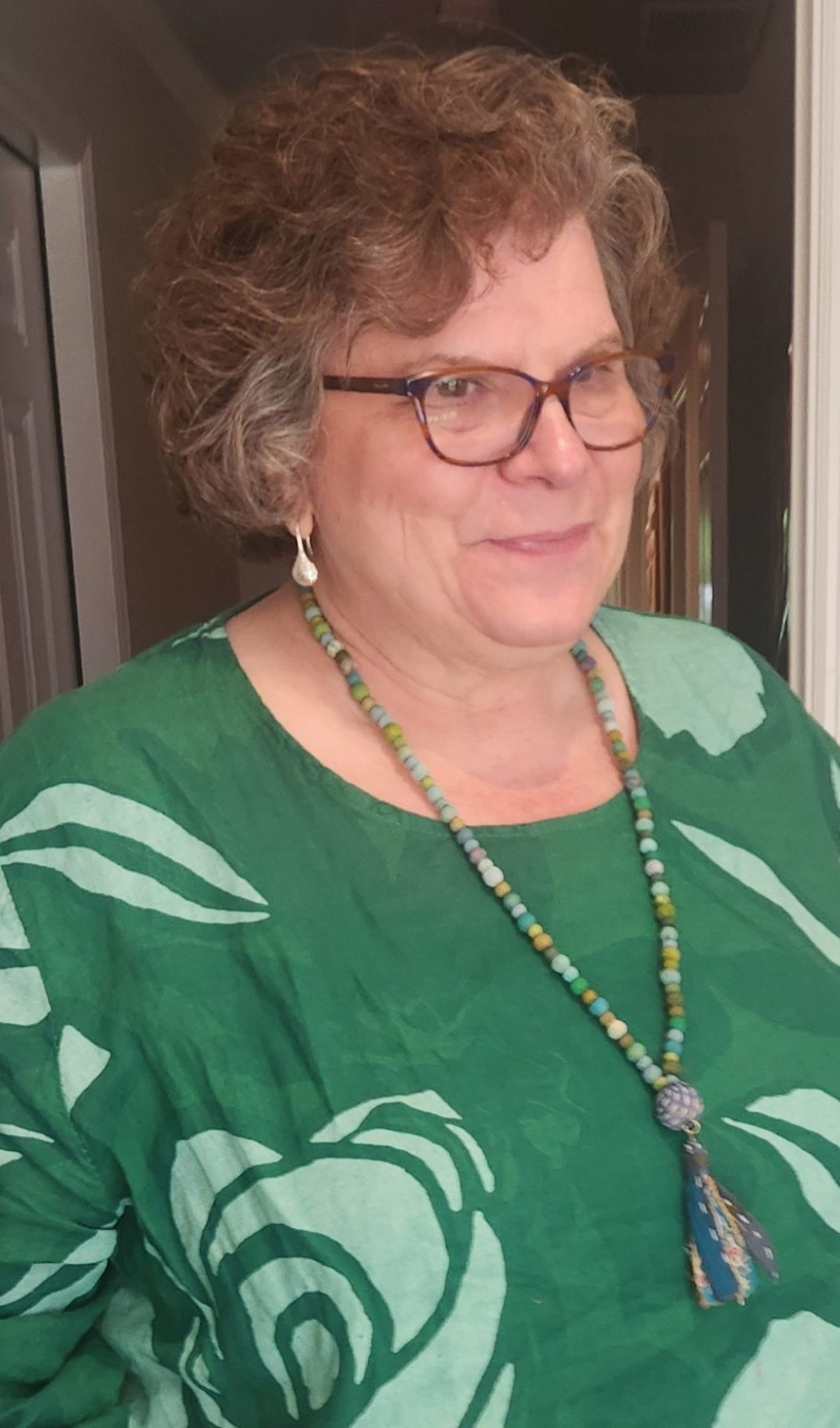Beaufort Mayor Murray, BMH doctor sit down to discuss COVID, vaccines as cases remain high in county, state
Above: Tony Junker, right, of S&K Signs and Designs, adjusts one of his cameras on Dr. Luke Baxley, left, an emergency room physician with Beaufort Memorial Hospital, prior to the start of the online “Community Conversation” on Tuesday at the home of Beaufort Mayor Stephen Murray, center. Beaufort has seen an explosion of new COVID-19 cases. Dr. Baxley said he has written COVID as “cause of death” far more times than he ever thought he would. Photo by Bob Sofaly.
By Mike McCombs
In what he referred to as his “first” Community Conversation, hinting there might be more to come, City of Beaufort Mayor Stephen Murray sat down Tuesday, July 31, with Dr. Luke Baxley, a, Emergency Room physician at Beaufort Memorial Hospital, in Murray’s home to discuss COVID and vaccines as the numbers remain high at BMH and across the county and state.
S.C. Department of Health and Environmental Control reported 3,757 new cases of COVID and 28 COVID deaths on Tuesday with a positivity rate of 12.3 percent.
Over the three-day holiday weekend, there were 16,628 news cases reported, along with 164 deaths statewide, according to DHEC.
There were 91 new cases reported in Beaufort County on Tuesday, but the rolling seven-day average for new cases is at 157. There were 13 COVID deaths reported over the last week in Beaufort County.
At BMH, there were 53 COVID patients Monday, 46 of those unvaccinated. Ten are in the ICU and eight are on ventilators – all unvaccinated.
Baxley, a doctor for 13 years, has worked in the BMH ER for roughly a decade. He visited Beaufort City Council abut six months ago to talk about vaccines.
“I thought it might be informative for some folks,” Murray said. “… over the last three or four weeks, I’ve been fielding a lot of questions about vaccines, about their efficacy, about their safety, which makes me a little uncomfortable because I’m a mayor, not a medical doctor. And I thought it would be good to have Dr. Baxley come on and chat.”
Murray asked his own questions for the first part of the conversation before viewers had their questions addressed.
Here’s a sampling of roughly a third of the conversation. To watch the conversation in it’s entirety, visit https://bit.ly/3jRvMzq.
* * *
Murray: Will you talk a little bit about what your day looks like at the ER and what you and the nurses and other doctors are having to deal with at BMH on a daily basis?
Baxley: We do shift work and we come in and pick up patients who are waiting to be seen. Most of it used to be your run of the mill emergencies, some of it, mixed in, your primary care. But rapidly, that’s turned into COVID. COVID, COVID, COVID, and more COVID. And complications of COVID. Initially in the first wave and the second little hump, we were fearful taking care of these people. We were all unvaccinated. We waited and waited, if we could just hold out for this vaccine and finally put an end to this. And it did, and we found that it’s been underutilized. Really underutilized. We’ve given this virus a chance to mutate, and it has. I’m sure all you guys are familiar with the Delta variant, more virulent, more aggressive, way more contagious. More likely to give you symptoms, more likely to put you in the hospital, more likely to kill you. And that’s what 80 percent of the infections were seeing at the hospital are, the Delta variant. And it’s frustrating because it’s … entirely preventable.
* * *
Murray: I understand that your seeing between 140 and 180 patients a day coming into the ER?
Baxley: Yes.
Murray: Which is pretty significant …
Baxley: Initially we saw kind of a drop, with people afraid to come to the hospital. But now that that’s kinda gone away, and people are coming in, and we’re getting COVID and regular emergencies and it’s just stockpiling. … The bed situation is dire, the beds are filling up. The people who get sick with COVID and are coming in to the hospital, it’s not a two-day stay or a three-day stay. These people stay for weeks or months and occupy a bed in the hospital that would be used for the care of other patients. That’s now not available.
Murray: You went live today about your day. You treated a guy patient who had a heart attack, I think …
Baxley: Oh yes. Treated a heart attack today in the hallway. No monitor, no … well, we eventually got help. And the only place to put them was in the hallway because every bed was occupied and a large majority of that was from patients with COVID. Unvaccinated patients with COVID.
* * *
Murray: I keep telling people, being unvaccinated and going into the hospital, you’re really putting other people that are not COVID patients at risk.
Baxley: Absolutely. That’s kind of what I’ve been talking about for a while. COVID doesn’t just hurt people that get COVID. This is how COVID kills people that don’t get COVID. It occupies the hospital bed where they should be treated. It fills up the hospital to max capacity and there’s limited resources to take care or what we normally take care of – heart attacks, stokes, car accidents, trauma.
* * *
Murray: Are you vaccinated?
Baxley: Oh yeah.
Murray: And I understand like 96 percent of physicians are vaccinated?
Baxley: Absolutely. Yep. And nursing staff. And PAs. And staff. And mid-level providers.
Murray: I heard over 80 percent (at Beaufort Memorial). Besides the travel nurses, besides the contract nurses, you’re over 80 percent vaccinated.
Baxley: Yeah. And climbing.
Murray: And so you think everybody who’s eligible should go get vaccinated?
Baxley: Yes.
Murray: And so you think the vaccines are safe?
Baxley: I do. I do. And it’s not just me, but all of the governing bodies of the major academic institutions agree and have put forth in very firm language saying that all patients 12 and older should be vaccinated.
* * *
Murray: FDA gave approval last week …
Baxley: Yes.
Murray: … which I think was a really important milestone …
Baxley: Huge.
Murray: … because I’ve heard from a lot of folks, “Well, it’s not even FDA approved.”
Baxley: Huge milestone.
Murray: But I hear often from folks that the vaccines were developed so quickly and how were we able to develop them so quickly and because they were developed so quickly, there’s a concern. I tell folks, “It’s good to be skeptical these days.” I’m a skeptic by nature. I think it’s important for folks to do there own research, to look at things, to ask questions, to look at different sources. But at a certain point, you have to make a decision based on all the data that’s presented to you. So will you talk a little bit about the FDA approval process or the clinical trials or the why the perception that is was created so quickly may be inaccurate?
Baxley: Like how it was pushed out so fast and how it’s brand new and it’s got to be dangerous because one day it was not here, and now it is here? I get that question a lot, and it has to do, … of course it’s multi-factorial, … the way they pushed it out so fast … both in study design and some factors they had in their favor, one of which is anytime you try to study a new medication or new vaccine, you have to have willing participants to participate in the study. And that’s one of the hardest parts is going knocking on doors and like, “hey, can we get you to participate in this trial?” A lot of people …
Murray: Don’t want to be guinea pigs?
Baxley: Right. Well, not now. When it first rolled out and the vaccine trials started, hundreds of thousands of people tried to sign up to participate in this trial, so there was no shortage of participants. The other thing is the data analyzed throughout the world was made freely available, so people in Chine sequenced the genome of the virus, and instead of keeping it to themselves, they released it,and gave charge to whatever scientist could start working on this. And the other thing is that the mRNA, the science behind it is not necessarily new. It was already around. For decades, for 20 years. They’ve already used it in Guinea and Sierra Leone to stop an ebola outbreak. … So the science was there, the participants were there. They green lighted it and fully funded it and pushed it forward. The analogy is, the best way to put it … you’re in an ambulance, you’re sick or injured and you need to get to the hospital quickly and safely. You just turn the sirens on and everyone moves out of the way and you make it easily to the hospital. … They green lighted it, they funded it, they had a ton of willing participants and they studied it quickly. They didn’t skip any of the steps that the FDA requires for approval. There’s a clear step-wise process that they have to follow to … be approved. They didn’t skip any of those steps. There’s two governing bodies that look at and analyze the data that come from these safety trials, and those two, one advises the CDC and one advises the FDA, and they’re made up of scientists. Not politicians or government officials. These are scientists and doctors at the top of their field that loo at this data and say, with certainty, that this is safe and this is effective. And honestly, it’s the safest vaccine that we have to date.
* * *
Baxley: I’ve never seen small pox. And I’ve never seen polio. And I never will. Because someone made a vaccine. And people took it. And it’s gone.
Mike McCombs is the editor of The Island News and can be reached at TheIslandNews@gmail.com.
BEAUFORT COUNTY SCHOOLS STILL HIT HARD
From Aug. 31 through Sept. 5, 220 more students and 16 more faculty and staff members in the Beaufort County School District have tested positive for COVID.
The number of students quarantined is 2,839, roughly 13.5 percent or a little more than one in eight students. There are 49 faculty and staff members quarantined.
That brings the total number of positive cases for the first two weeks of the school year to 608 students and 62 faculty and staff members.
The Beaufort Board of Education is awaiting a S.C. Supreme Court ruling on a mask mandate enacted by Richland County before voting on a mask mandate of it’s own
– Staff reports











